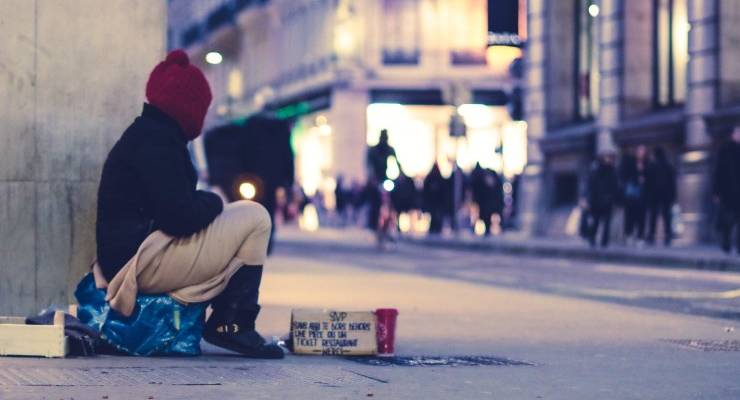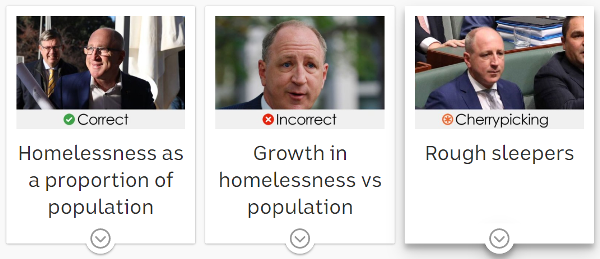
The claims
Newly appointed Assistant Minister for Community Housing, Homelessness and Community Services Luke Howarth caused controversy last week when he said he wanted to put a “positive spin” on homelessness in Australia.
Ahead of his meeting to discuss housing with the lord mayors of Australia’s capital cities, Mr Howarth told ABC Radio National’s Hamish MacDonald that homelessness affects a “very, very small percentage of the population”.
He claimed that 99.5% of the Australian population is housed, stating that “about half a per cent of the population don’t have a permanent roof over their head”.
Mr Howarth added that the rate of increase in the number of people experiencing homelessness had not outstripped population growth.
“[The increase in homelessness] is actually not ahead of population growth. The population from the last census to the previous one increased by almost 20%,” he said.
Mr Howarth also claimed during the interview that there had been a decrease in the number of rough sleepers.
He said the number of people “living in impoverished dwellings or people living on the street” had fallen from 8,946 to 8,200 over a 15-year period to 2016.
So, how do we make sense of all these figures and claims? RMIT ABC Fact Check’s recently published homelessness interactive provides the basis for a thorough analysis.
The verdicts
Mr Howarth’s claims get mixed verdicts.
Of his three claims, Fact Check found one to be correct, one to be incorrect, and one to be a case of cherrypicking.

Mr Howarth is correct in saying people experiencing homelessness make up only 0.5% of the Australian population.
The figure translates to 1 in 200 people being homeless.
Mr Howarth’s claim that the rate of increase in homelessness lagged population growth is incorrect.
Between 2011 and 2016, the Australian population grew by 8.8% (not 20%, as claimed by Mr Howarth), while the homeless population grew by 14%.
Mr Howarth’s claim that the number of people “living in impoverished dwellings or people living on the street” has fallen from 8,946 to 8,200 is cherrypicking.
His decision to cite figures for rough sleepers over 15 years, ignores a sharp rebound in rough sleeping numbers in the most recent five years to 2016.
The full rationale for Fact Check’s decisions follows below.
What is homelessness?
Homelessness is defined as a loss of a sense of security, stability, privacy or safety, or the ability to control your living space.
The ABS’s Census of Population and Housing, last conducted in August 2016, provides the most comprehensive picture of homelessness in Australia.
The census categorises homelessness according to six living situations: rough sleeping, supported accommodation for the homeless, temporary accommodation with other households, boarding houses, other temporary lodgings, and severely overcrowded accommodation.
Fact Check’s homelessness interactive
Without a Home is Fact Check’s analysis of the state of homelessness in Australia.
Compiled using homelessness data from the 2016 census, as well as Specialist Homeless Services (SHS) data collected by the Australian Institute of Health and Welfare, Without a Home presents the facts on homelessness, pointing out key changes over time with a focus on the groups most affected.
Fact Check worked in conjunction with experts from RMIT University’s Social and Global Studies to ensure the interactive represented the data accurately.
Fact Check has drawn on Without a Home to analyse Mr Howarth’s claims.
Does homelessness only affect 0.5% of the population?
According to the census, which put the total population at 23.4 million, 116,400 people were homeless in 2016.
That means Mr Howarth’s claim that “about half a per cent of the population don’t have a permanent roof over their head” is correct.
In other words, one in 200 Australians are experiencing homelessness.
According to the data, those in severely overcrowded dwellings made up the largest proportion of people without a home, at 44%.
Of the remainder, the proportion of people living in supported accommodation was 18%, temporary accommodation with other households (15%), boarding houses (15%), rough sleeping (7%) and other temporary lodgings (1%).
Almost a third (32%) of Australia’s homeless population lived in New South Wales.
Other states and territories accounted for 21% (Victoria), 19% (Queensland), 12% (the Northern Territory), 8% (Western Australia), 5% (South Australia) and 1% (both the ACT and Tasmania).
Does the increase in people experiencing homelessness simply reflect population growth?
The latest figures show an increase of 14% in the number of homeless people since the previous census in 2011.
But the increase cannot be pinned on population growth alone.
Over the same period, the population increased by 8.8% — not 20%, as claimed by Mr Howarth — from 21.5 million people in 2011 to 23.4 million in 2016.
The homelessness rate — that is, the number of people experiencing homelessness per 10,000 Australians — has also risen over the same period.
In 2011, 47.6 people per 10,000 Australians were experiencing homelessness. This rose to 49.8 in 2016, representing an increase in the homelessness rate of 4.6%.
So, Mr Howarth’s claim that the growth in homelessness is “not ahead of population growth” is incorrect.
Has rough sleeping decreased?
According to census data, there were 8,946 rough sleepers in Australia in 2001 — that is, people living in impoverished dwellings or tents, or who were sleeping out.
By 2016, that number had declined to 8,200. This is the 15-year period to which Mr Howarth referred.
However, the figures disguise a sharp rebound in the number of rough sleepers over the most recent five-year period.
The 2011 census put the number of rough sleepers at 6,810 (a rate of 3.2 people per 10,000 of population).
By 2016, the figure had risen by 20% to 8,200 (a rate of 3.5 per 10,000).
Principal researcher: Ellen McCutchan







Yeah, so, how does having 0.5% of the population being homeless right now qualify it as not much of a problem? That is a *lot* of people, a shamefully large number of people.
The only “positive” spin I can think of when it comes to this social malady (in a country as well-off as ours) would be this government being homeless – then they might realise what a bit of reality looks and feels like.
“‘Hedley’ Howarth, I’ve got an idea……. “Homeless the Musical”? All I need is the money. How about it – you, Schemo, Spud, Fraudberg, “The Magic” Christian, The Belgian Waffler, can all come to the opening ….. front row seats, promise.”